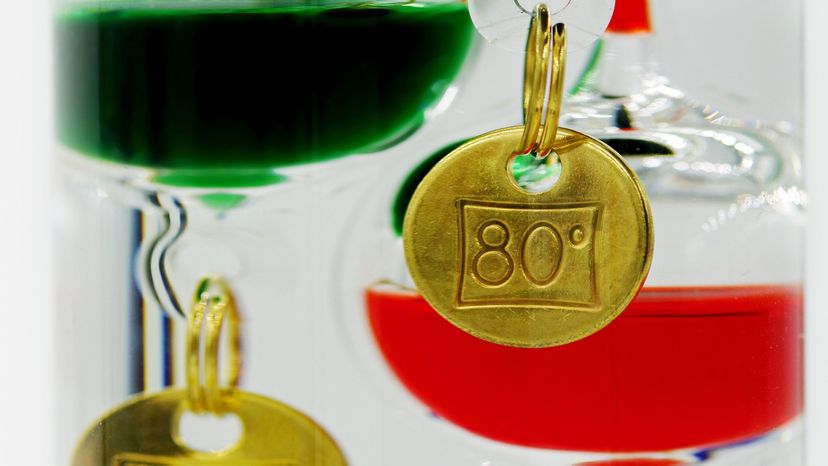
Based on a thermoscope invented by Galileo Galilei in the early 1600s, the thermometer on your co-worker's desk is called a Galileo thermometer. A simple, fairly accurate thermometer, today it is mostly used as decoration. The Galileo thermometer consists of a sealed glass tube that is filled with water and several floating bubbles. The bubbles are glass spheres filled with a colored liquid mixture. This liquid mixture may contain alcohol, or it might simply be water with food coloring.
Attached to each bubble is a little metal tag that indicates a temperature. A number and degree symbol are engraved in the tag. These metal tags are actually calibrated counterweights. The weight of each tag is slightly different from the others. Since the bubbles are all hand-blown glass, they aren't exactly the same size and shape. The bubbles are calibrated by adding a certain amount of fluid to them so that they have the exact same density. So, after the weighted tags are attached to the bubbles, each differs very slightly in density (the ratio of mass to volume) from the other bubbles, and the density of all of them is very close to the density of the surrounding water.
Advertisement
If you have read this question, then you know that an object immersed in a fluid experiences two major forces: the downward pull of gravity and the upward push of buoyancy. It is the downward force of gravity that makes this thermometer work.
The basic idea is that as the temperature of the air outside the thermometer changes, so does the temperature of the water surrounding the bubbles. As the temperature of the water changes, it either expands or contracts, thereby changing its density. So, at any given density, some of the bubbles will float and others will sink. The bubble that sinks the most indicates the approximate current temperature.
Consider this example:
Let's say there are five bubbles in the thermometer:
- A blue bubble that represents 60 degrees
- A yellow bubble that represents 65 degrees
- A green bubble that represents 70 degrees
- A purple bubble that represents 75 degrees
- A red bubble that represents 80 degrees
The blue bubble (60 degrees) is the heaviest (densest) bubble, and each bubble thereafter is slightly lighter, with the red bubble being the lightest. Now, let's say the temperature in the room is 70 degrees. Since the surrounding air is 70 degrees, we know the water inside the thermometer is also about 70 degrees. The blue and yellow bubbles (60 and 65 degrees, respectively) are calibrated so that they have higher densities than the water at this temperature, so they sink. The purple and red bubbles each have a density that is lower than the surrounding water, so they float at the very top of the thermometer. Since the green bubble is calibrated to represent 70 degrees, the same temperature as the water, it sinks slightly so that it is floating just below the purple and red bubbles -- thereby indicating the room's temperature!
Advertisement

